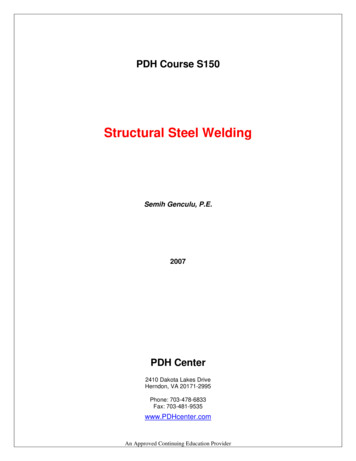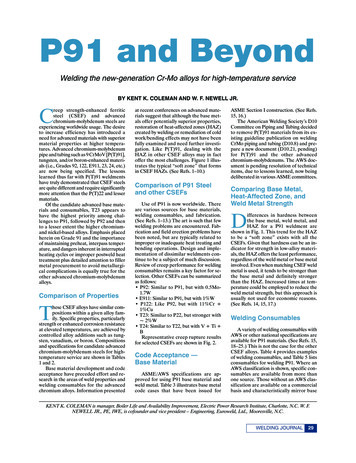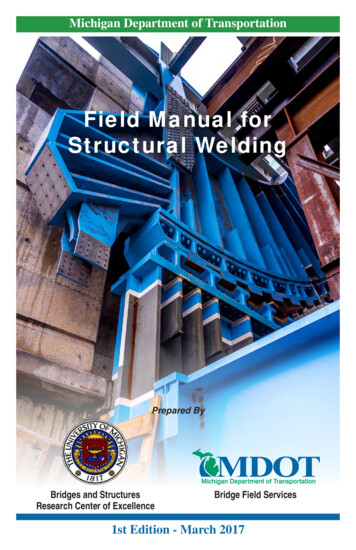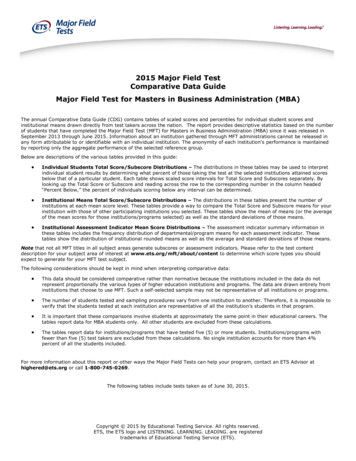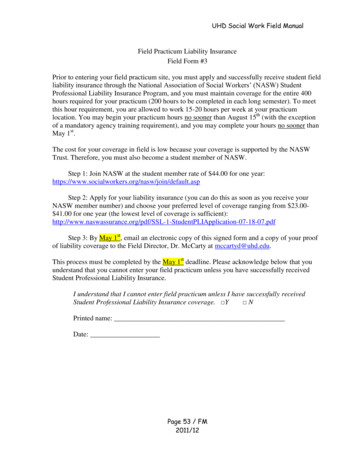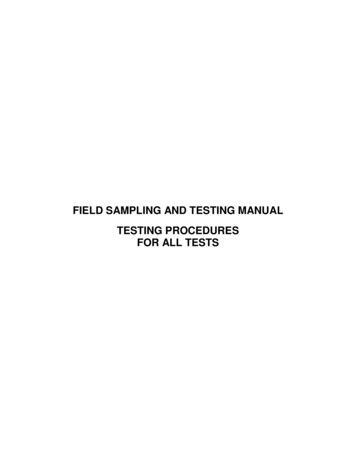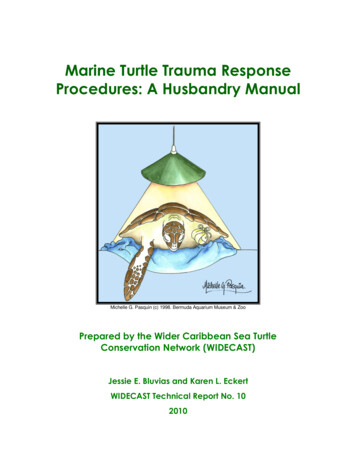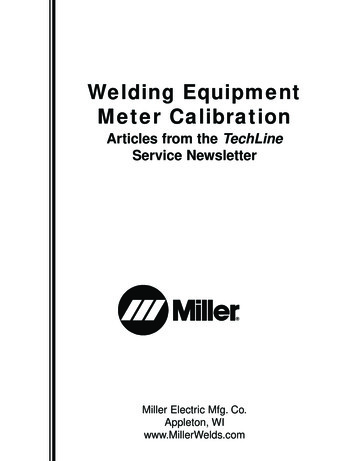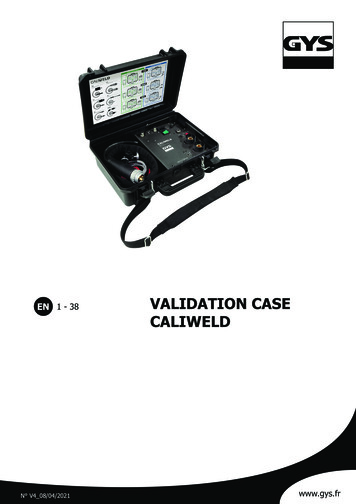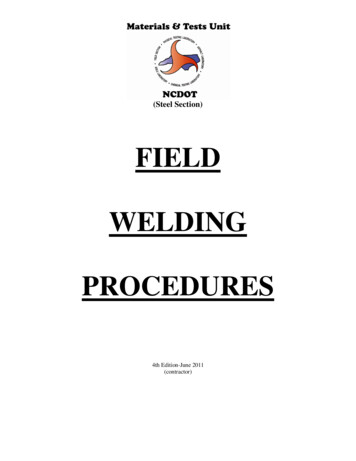
Transcription
(Steel Section)FIELDWELDINGPROCEDURES4th Edition-June 2011(contractor)
Table of ContentsDescriptionPage NumberCover SheetTable of ContentsIntroductionGeneral InformationReference StandardsQualification of PersonnelQualification of Welds and ProceduresWorkmanshipWeld ProfilesRepairing WeldsWeld CleaningBacking BarPreheat and Interpass TemperatureElectrode StorageWeld Acceptance CriteriaStud WeldingEquipment RequirementsG-1G-1G-2G-2, G-3G-3G-4G-4G-4G-4G-5G-6G-7G-7Welding ProceduresH-Pile Welding Procedure (WPS 1)Steel Girder Bearing Plate Welding Procedure (WPS 2)Pipe Pile Welding Procedure (WPS 3)Concrete Girder Sole Plate Welding Procedure (WPS 4)Steel Girder SIP Angle Welding Procedure (WPS 5)Concrete Girder SIP Angle Welding Procedure (WPS 6)Stud Welding Procedure (WPS 7)Fillet Weld Certification Welding Procedure (WPS 8)3G-4G Plate Certification Welding Procedure (WPS 9)6G Pipe Certification Welding Procedure (WPS 10)SIP Certification Welding Procedure (WPS 11)Encasement Pipe Welding Procedure (WPS 12)Steel Girder Bearing Plate Weathering Steel (unpainted) Welding Procedure (WPS 13)Overhang Bracket Welding Procedure (WPS 14)Steel Girder SIP Strap Welding Procedure (WPS 15)Pipe Pile Bottom Driving Plate (WPS 16)Pot Bearing Welding Procedure (WPS 17)Soldier Pile Welding Procedure (WPS 18)Single V-Groove with Backing (WPS 21)Single V-Groove with Back Gouge (WPS 22)Double Bevel Groove with Back Gouge (WPS 23)Double V-Groove with Back Gouge (WPS 25)Fillet Weld (WPS 27)Armor Angle Field Splice (WPS 28)Single U-Groove with Back Gouge (WPS 29)1-1 thru 1-22-1 thru 2-23-1 thru 3-34-1 thru 4-25-1 thru 5-26-1 thru 6-27-1 thru 7-28-1 thru 8-29-1 thru 9-210-1 thru 10-211-1 thru 11-212-1 thru 12-213-1 thru 13-214-1 thru 14-215-1 thru 15-216-1 thru 16-217-1 thru 17-218-1 thru 18-521-1 thru 21-222-1 thru 22-223-1 thru 23-225-1 thru 25-227-1 thru 27-428-1 thru 28-229-1 thru 29-2T-1I-1Appendix A (Welding Terms and Definitions)Appendix C (Welding Symbols)Appendix D (references, credits and Steel Section contact information)Appendix E (list of revisions)T-1A-1 thru A-9D-1E-1, E-2
IntroductionThe information contained within this book of Approved Welding Procedures is intended toassist the NCDOT Construction Inspector and guide the Welding Contractor with acceptableprocedures and practices for the application of weld in a field environment on NCDOT bridgeprojects. Additional information and procedures have been included to assist BridgeMaintenance Personnel with "Repair of Existing Structures". The information is in no wayconsidered to be complete or all encompassing but instead offers aid to some of the mostcommon applications to field welding that are found on NCDOT bridge construction projects. AWelding Procedure Specification (WPS) may be generated by an authorized person (i. e. CWI)and then submitted to the NCDOT Materials & Tests Unit (Steel Section) at 770A Park CentreDrive in Kernersville, NC 27284 (phone: 336-993-2300) for approval in the event that thecontractor does not want to utilize the material provided.These approved welding procedures may also be found at the following web als/structural/appr proc.htmlThis manual may also be found at the following web als/pdf/fwp.pdfPrevious editions of this manual include:1st Edition-October 20082nd Edition-April 20093rd Edition-May 2010I-1
General InformationReference StandardsAs stated by the NCDOT “Standard Specifications For Roads and Bridges JULY 2006” page 455 section 440-7:“Perform field welding only when called for on the plans and in accordance with 1072-20.”“Remove paint or galvanizing at the location of field welds by blast cleaning (SSPC SP-6 finish),or hand (SSPC SP-2 finish) or power tool cleaning (SSPC SP-3 finish) just prior to welding.Clean sufficiently to prevent contamination of the weld by the paint.”note: Refer to Appendix B for SSPC standards.The NCDOT “Standard Specifications For Roads and Bridges JULY 2006” page 10-141 section1072-20 makes reference to the ANSI/AWS/AASHTO Bridge Welding Code D-1.5 and states insection 1072-20 (B) General “Weld all structural steel in the shop or in the field for bridges,whether permanent or temporary, and perform all other work related to structural weldingincluding, but not limited to, testing and inspection of welds, preparation of material, oxygencutting, electrodes, shielding, and shear studs, meeting the requirements of the Bridge WeldingCode. Weld other steel items in accordance with the requirements of the applicable AWSWelding Code.”"Weld only where shown on the plans or where called for in the Specifications unless requestingand receiving written approval for additional welding."Additional governing information pertaining to field welding can be found on contractdocuments such as NCDOT approved plans and special provisions.Qualification of PersonnelFor the purpose of field welding on NCDOT construction projects, all personnel must be testedand approved by the NCDOT Materials & Tests Unit (Steel Section). Prior to performing anywelding activities, the qualified person must present the Welder ID card that was issued by the M& T Unit along with another photo ID, such as a driver’s license, to the NCDOT representative(i. e. Construction Inspector). Currently there are three levels of NCDOT field weldercertification.SIP Welder- This certification qualifies a welder to weld stay in place deck forms togirders.Bridge Welder- This certification qualifies a welder to weld anything on a project exceptpipe less than 24 inches in diameter.Pipe Welder: This certification qualifies a welder to weld anything on a project.Additional information about welder certification can found at the following web als/pdf/fwcprocedure.pdfG-1
Qualification of Welds and Procedures(7-21-09)R43SP10Page 10-143, Subarticle 1072-20(D) Qualification of Welds and Procedures, replace the thirdsentence of the first paragraph with the following:For all prequalified field welds, submit Welding Procedure Specifications (WPS) for each jointconfiguration for approval at least 30 days prior to performing any welding. In lieu of this, usethe WPS provided and pre-approved by the Department. These pre-approved WPSs areavailable from the Materials and Tests Unit or tructural/appr proc.htmlUse non-prequalified welds only if approved by the Engineer. Submit WPS for all nonprequalified welds to the Engineer for approval. At no cost to the Department, demonstrate theiradequacy in accordance with the requirements of the Bridge Welding Code.ApplicationAWS D-1.5 Section 1.1.1 This code covers welding fabrication requirements applicable towelded highway bridges. The code is applicable to both shop and field fabrication of steelbridges and bridge components,WorkmanshipAWS D-1.5 Section 3.1.3 Welding shall not be done when the ambient temperature is lower than0 F, when surfaces are wet or exposed to rain, snow, or high wind velocities, nor when weldersare exposed to inclement conditions.AWS D-1.5 Section 3.2.1 Surfaces and edges to be welded shall be smooth, uniform, and freefrom fins, tears, cracks, and other discontinuities which would adversely affect the quality orstrength of the weld. Surfaces to be welded and surfaces adjacent to a weld shall also be freefrom loose or thick scale, slag, rust, moisture, grease, and other foreign material that wouldprevent proper welding or produce objectionable fumes. Mill scale that can withstand vigorouswire brushing, a thin rust-inhibitive coating, or antispatter compound may remain AWS D-1.5 Section 3.2.2 In all thermal cutting, the cutting flame shall be so adjusted andmanipulated as to avoid cutting beyond (inside) the prescribed lines. The roughness of thermalcut surfaces shall be no greater than that defined by the American National Standards Institute,ANSI B46.1, Surface Texture. For material up to 100mm [4 in] thick, the maximum surfaceroughness value shall be 25 µm (1000 µin). Steel and weld metal may be thermally cut,provided a smooth and regular surface free from cracks and notches is secured, and provided thatan accurate profile is secured by the use of a mechanical guide. Free-hand thermal cutting shallbe done only where approved by the Engineer.G-2
Workmanship (cont.)AWS D-1.5 Section 3.2.4 Reentrant corners of base-metal cut edges shall be formed to provide asmooth transition with a radius of not less than 25mm [1 in] that meets the adjacent edgeswithout offset or cutting past the point of tangency. The reentrant corners must be formed bythermal cutting, followed by grinding to meet the surface requirements of 3.2.2.AWS D-1.5 Section 3.3.1 The parts to be joined by fillet welds shall be brought into as closecontact as practical. The root opening shall not exceed 3/16” except in cases involving eithershapes or plates 3” or greater in thickness if, after straightening and in assembly, the rootopening cannot be closed sufficiently to meet this tolerance. If the root opening is greaterthan 1/16”, the leg of the fillet weld shall be increased by the amount of the root opening or theContractor shall demonstrate that the required weld size has been obtained.AWS D-1.5 Section 3.3.1.2 The use of filler plates shall be prohibited except as specifiedon the drawings or as specially approved by the Engineer AWS D-1.5 Section 3.3.3 Parts to be joined by groove welds shall be carefully aligned. Wherethe parts are effectively restrained against bending due to eccentricity in alignment, the offsetfrom theoretical alignment shall not exceed 10% of the thickness of the thinner part joined, but inno case shall be more than 1/8”.AWS D-1.5 Section 3.3.7 Tack welds shall be subject to the same quality requirements as thefinal welds.AWS D-1.5 Section 3.3.8 Temporary welds shall be subject to the same WPS requirements asfinal welds. They shall be removed unless otherwise allowed by the Engineer. When they areremoved, the surface shall be made flush with the original surface. There shall be no temporarywelds in tension zones Weld ProfilesAWS D-1.5 Section 3.6.1.1 (in reference to fillet weld profiles) The convexity of a weld orindividual surface bead shall not exceed 0.07 times the actual face width of the weld orindividual bead, respectively, plus 1.5mm [0.06 in].AWS D-1.5 Section 3.6.2 (in reference to groove weld profiles) Groove welds shall preferablybe made with slight or minimum face reinforcement except as may be otherwise provided. In thecase of butt and corner joints, the face reinforcement shall not exceed 3mm [1/8 in] in height andshall have gradual transition to the plane of the base surface. They shall be free of thediscontinuities shown for butt joints.AWS D-1.5 Section 3.6.5 Welds shall be free from overlap.G-3
Repairing WeldsAWS D-1.5 Section 3.7.2 The Contractor has the option of either repairing an unacceptableweld, or removing and replacing the entire weld. If the Contractor elects to repair the weld, itshall be corrected as follows:AWS D-1.5 Section 3.7.2.1 Overlap or Excessive Convexity. Excess weld metal shall beremoved.AWS D-1.5 Section 3.7.2.2 Excessive Concavity of Weld or Crater, Undersize Welds,Undercutting. Surfaces shall be prepared (see 3.11) and additional weld metal deposited.AWS D-1.5 Section 3.7.2.3 Excessive Weld Porosity, Excessive Slag Inclusions,Incomplete Fusion. Unacceptable portions shall be removed and re-welded.AWS D-1.5 Section 3.7.2.4 Cracks in Weld or Base Metal. The extent of the crack shallbe ascertained by use of MT, PT, or other equally positive means; the metal shall beremoved for the full length of the crack plus 500mm [2 in] beyond each end of the crack,and re-welded.Weld CleaningAWS D-1.5 Section 3.11.1 In-Process Cleaning. Before welding over previously depositedmetal, all slag shall be removed and the weld and adjacent base metal shall be brushed clean.This requirement shall apply not only to successive layers but also to successive beads and to thecrater area when welding is resumed after an interruption.AWS D-1.5 Section 3.11.2 Cleaning of Completed Welds. Slag shall be removed from allcompleted welds, and the weld and adjacent base metal shall be cleaned by brushing or othersuitable means. Tightly adherent spatter remaining after the cleaning operation shall beacceptable unless its removal shall be required for the purpose of NDT or painting. Weldedjoints shall not be painted until after welding has been completed and the weld has beenaccepted.Backing BarAWS D-1.5 Section 3.13.5 Steel backing shall be placed and held in intimate contact with thebase metal. The maximum gap between steel backing and the base metal at the weld root shallbe 2 mm (1/16 in).G-4
Preheat and Interpass TemperatureUnless stated otherwise on the approved welding procedure, all preheat temperatures on NCDOTprojects shall be 100 F.AWS D-1.5 Section 4.2.7 When the base metal is below the temperature listed for the weldingprocess being used and the thickness of material being welded, it shall be preheated (except asotherwise provided) in such a manner that the steel on which weld metal is being deposited is ator above the specified minimum temperature for a distance equal to the thickness of the partbeing welded, but not less than 75mm [3 in] in all directions from the point of welding.AWS D-1.5 Section 4.2.8 Preheat and Interpass Temperature Requirements When the basemetal temperature is below 0 C [32 F], the base metal shall be heated to at least 20 C [70 F],and this minimum temperature shall be maintained during welding.Electrode StorageAWS D-1.5 Section 4.5.2 All electrodes having low hydrogen coverings conforming to AWS5.1/A5.1M shall be purchased in hermetically sealed containers Immediately after opening thehermetically sealed container or removal of the electrodes from drying ovens
AWS D-1.5 Section 3.3.7 Tack welds shall be subject to the same quality requirements as the final welds. AWS D-1.5 Section 3.3.8 Temporary welds shall be subject to the same WPS requirements as final welds. They shall be removed unless otherwise allowed by the Engineer. When they are removed, the surface shall be made flush with the original surface. There shall be no temporary welds in .

